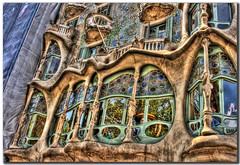
At first glance the "Social Media Revolution 2" video is very bright, fast paced, and has funky and energizing music in the background. Who was this advertisement targeted for? Me, you, teenagers, or anyone?
There are very powerful statements made throughout the video regarding social media and its popularity and place in our modern culture.
Here is some food for thought from the statements made throughout the video:
- "Is Social Media a Fad? Or the biggest shift since the Industrial Revolution?"
- "Social Media has overtaken pornography as the #1 activity on the web."
- "Facebook added over 200 million users in less than a year."
- "U.S. Department of Education study revealed that online students out performed those receiving face to face instruction..."
- "80% of companies use social media for recruitment."
"We don't have a choice on whether we DO social media, the question is how well we Do it."
- Erik Qualman
This video (advertisement) effectively shows how our culture is being impacted by social media and how this isn't just a new fad...it will be around for a while! It's a very powerful resource for students, teachers, and anyone out there. Students now have access to a profound amount of knowledge at their fingertips.
But, my question is are they (students) using this technology to access knowledge? Or is this just a way for them to build their social network and talk about their lives?
As an educator, I see the true value behind incorporating technology into curriculum; it can be an amazing tool to link students to the rest of the world and experience other cultures. They can learn ways to communicate with other cultures, to do research, etc. It can also form a way for them to analyze and interpret news articles, translations, cultural topics etc. prior to entering the classroom. They can work on an assignment and form personal opinions while also reading their classmates opinions, which hopefully would lead to powerful classroom discussions. It would be a great tool to help the soft spoken students excel and develop a voice. Students who aren't as outspoken as their peers would take more time to express their opinions prior to posting a blog about an assignment.
On the other hand are students using this new technology as a means to leap onto the band wagon and create a heightened sense of self importance and social networking?
I-pad, I-pod, MySpace, ...etc. it's all about ME! Yes this technology has stimulated a craze in communication and expression of opinions, but opinions aren't facts! Do they know that? Some Internet savvy speakers post about all different kinds of topics, but is there substance and fact behind their statements? Not always. As an educator, when I incorporate technology into my curriculum, I have to educate my students on the positives and negatives behind the information they encounter on the Internet. I would use the Internet as a tool for them to learn how to decipher the creditability of what they are reading or looking at. I would want my students to choose their words wisely and make statements that count, statements that are thoughtful and supported by facts.
"Social Media isn't a fad, it's a fundamental shift in the way we communicate."
It's "our" culture but I feel like it's being run by something bigger, it's being created by modern day technology. Ready or not, here it is!
It's up to us to find a way to use it as an effective professional tool and to find a way to still stimulate thoughtful personal interactions.











